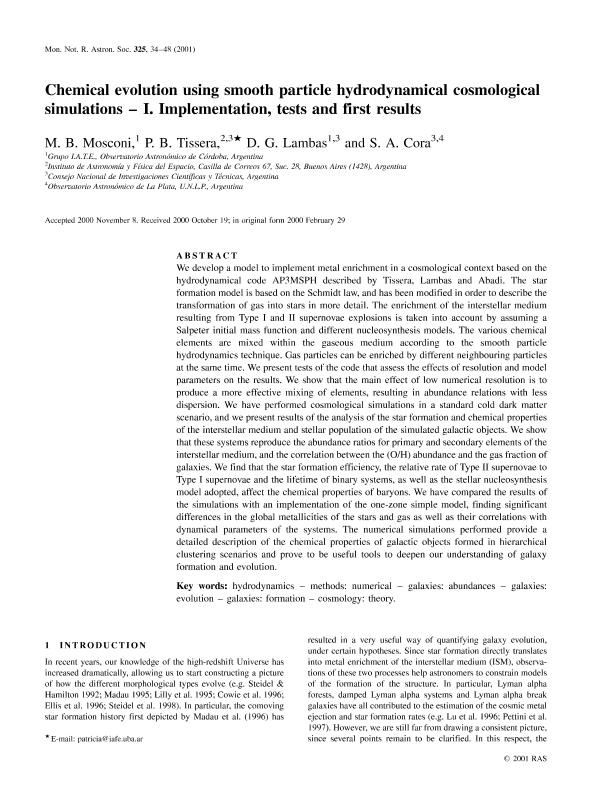Artículo
Chemical evolution using smooth particle hydrodynamical cosmological simulations - I. Implementation, tests and first results
Fecha de publicación:
07/2001
Editorial:
Oxford University Press
Revista:
Monthly Notices of the Royal Astronomical Society
ISSN:
0035-8711
Idioma:
Inglés
Tipo de recurso:
Artículo publicado
Clasificación temática:
Resumen
We develop a model to implement metal enrichment in a cosmological context based on the hydrodynamical code AP3MSPH described by Tissera, Lambas and Abadi. The star formation model is based on the Schmidt law, and has been modified in order to describe the transformation of gas into stars in more detail. The enrichment of the interstellar medium resulting from Type I and II supernovae explosions is taken into account by assuming a Salpeter initial mass function and different nucleosynthesis models. The various chemical elements are mixed within the gaseous medium according to the smooth particle hydrodynamics technique. Gas particles can be enriched by different neighbouring particles at the same time. We present tests of the code that assess the effects of resolution and model parameters on the results. We show that the main effect of low numerical resolution is to produce a more effective mixing of elements, resulting in abundance relations with less dispersion. We have performed cosmological simulations in a standard cold dark matter scenario, and we present results of the analysis of the star formation and chemical properties of the interstellar medium and stellar population of the simulated galactic objects. We show that these systems reproduce the abundance ratios for primary and secondary elements of the interstellar medium, and the correlation between the (O/H) abundance and the gas fraction of galaxies. We find that the star formation efficiency, the relative rate of Type II supernovae to Type I supernovae and the lifetime of binary systems, as well as the stellar nucleosynthesis model adopted, affect the chemical properties of baryons. We have compared the results of the simulations with an implementation of the one-zone simple model, finding significant differences in the global metallicities of the stars and gas as well as their correlations with dynamical parameters of the systems. The numerical simulations performed provide a detailed description of the chemical properties of galactic objects formed in hierarchical clustering scenarios and prove to be useful tools to deepen our understanding of galaxy formation and evolution.
Palabras clave:
Hidrodynamics
,
Numerical
,
Galaxies
Archivos asociados
Licencia
Identificadores
Colecciones
Articulos(IAFE)
Articulos de INST.DE ASTRONOMIA Y FISICA DEL ESPACIO(I)
Articulos de INST.DE ASTRONOMIA Y FISICA DEL ESPACIO(I)
Articulos(IATE)
Articulos de INST.DE ASTRONOMIA TEORICA Y EXPERIMENTAL
Articulos de INST.DE ASTRONOMIA TEORICA Y EXPERIMENTAL
Citación
Mosconi, M. B.; Tissera, Patricia Beatriz; Garcia Lambas, Diego Rodolfo; Cora, Sofia Alejandra; Chemical evolution using smooth particle hydrodynamical cosmological simulations - I. Implementation, tests and first results; Oxford University Press; Monthly Notices of the Royal Astronomical Society; 325; 1; 7-2001; 34-48
Compartir
Altmétricas




